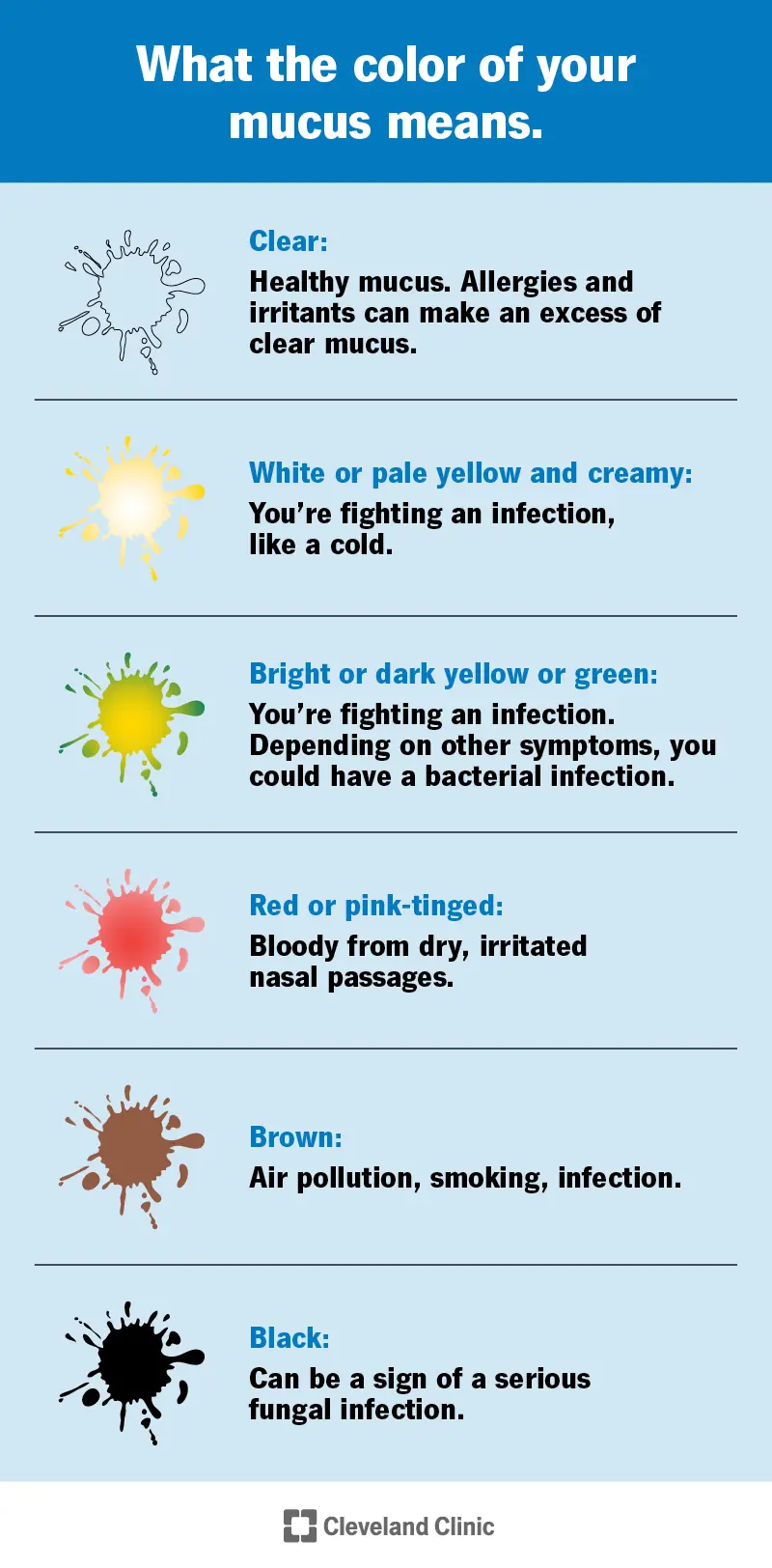
Understanding Mucus: What It Is, What It Means, and How to get rid of it
Mucus is a vital fluid produced by the body to protect and maintain the health of various organs and systems. While it’s often an afterthought—especially when you're struggling with excess mucus—it plays an essential role in keeping your body functioning properly. From your respiratory system to your digestive tract, mucus serves as a protective barrier against harmful pathogens and helps keep tissues lubricated. However, changes in the color, consistency, or amount of mucus can signal potential health issues. In this article, we will dive deeper into what mucus is, its functions, and what the color and consistency changes might mean for your health.
What is Mucus?
Mucus is a thick, slippery fluid secreted by specialized cells known as goblet cells, found primarily in the mucosal membranes of the body. These cells are located in several organs, including the nose, sinuses, respiratory tract, digestive system, urinary system, and reproductive systems. Mucus acts as a shield, trapping germs, allergens, and other harmful particles, preventing them from entering your body’s tissues. It also helps in lubricating and moisturizing different parts of the body, such as the respiratory and digestive systems, allowing them to function smoothly.
While mucus often becomes more noticeable when you’re sick—manifesting as the annoying congestion in your nose or chest—it’s constantly working to maintain your body’s health. You might know mucus by its other common names, such as snot, phlegm, or sputum, but no matter the name, it’s crucial for your immune system.
Functions of Mucus
Mucus performs several important tasks within the body. Its main functions include:
-
Blocking Pathogens: Mucus acts as a barrier, trapping germs, bacteria, viruses, and other harmful particles, preventing them from reaching your body’s tissues and causing infection.
-
Housing Immune Cells: Mucus contains antibodies that help identify and neutralize harmful pathogens, marking them for destruction by your immune system’s white blood cells.
-
Trapping Harmful Substances: Mucus helps capture airborne pollutants, dead cells, dust, and other particles, moving them out of the body to prevent further damage.
-
Lubricating Mucosal Membranes: It keeps areas such as your nasal passages, lungs, digestive system, and reproductive tract moist, which is essential for optimal functioning. For instance, in the digestive tract, mucus helps food pass smoothly through the intestines, and in the reproductive tract, it plays a key role in fertility by aiding sperm movement.
-
Facilitating Fluid Balance: Mucus contains water and electrolytes that help balance moisture levels in various body parts.
Where Does Mucus Come From?
Mucus is primarily produced by goblet cells in your mucosa, the tissue lining your body’s cavities that open to the outside world. These mucosal membranes are located in areas such as:
-
Respiratory System: Nose, sinuses, throat, and lungs.
-
Digestive System: Mouth, stomach, and intestines.
-
Reproductive Systems: Uterus, vagina, and male reproductive tract.
-
Urinary System: Bladder and urethra.
-
Sensory Organs: Eyes and ears.
The components of mucus, such as mucin (a glycoprotein), water, enzymes, antibodies, and electrolytes, give it a gel-like consistency that is essential for its protective functions.
What Does Mucus Look Like?

Cre: Cleveland Clinic
Mucus is typically clear, thin, and slippery under normal conditions. However, the color and thickness of mucus can change in response to various factors, such as infections, allergies, or irritants. Here’s what different colors of mucus could indicate:
-
Clear Mucus: Typically, when you're not sick, mucus is clear. This indicates normal function, such as when your body is combating irritants or allergens. A clear runny nose is common in people with allergies or sinus irritation.
-
White, Cream, or Light Yellow Mucus: Thick and creamy mucus that appears white or light yellow is often associated with a viral infection, such as the common cold or flu. It’s a sign that your immune cells are fighting off the infection.
-
Bright Yellow or Green Mucus: If mucus turns yellow or green, it often indicates a bacterial infection, like sinusitis or bacterial pneumonia. The color change is due to dead white blood cells and other immune system components being present in the mucus.
-
Red or Pink Mucus: Blood can make your mucus appear pink or streaked with red. This is common when the nasal passages are irritated or dry, or if you’ve been blowing your nose frequently. If you have persistent blood in your mucus, it’s essential to consult a healthcare provider.
-
Brown Mucus: Brown mucus could be a result of inhaling dust, pollution, tobacco smoke, or dried blood. In some cases, brown mucus can be a sign of an infection, especially if it is accompanied by other symptoms like fever or pain.
-
Black Mucus: Black mucus is usually the result of inhaling something harmful, such as smoke or pollutants. It may also indicate a serious fungal infection, particularly in individuals with weakened immune systems.
When Should You Be Concerned About Mucus Color?
While the color of mucus can be an indicator of the body’s response to infection or allergens, it cannot diagnose specific illnesses on its own. If you experience unusual or persistent changes in mucus color, especially if it is accompanied by symptoms such as facial pain, headaches, chest pain, or difficulty breathing, it's important to consult a healthcare provider. Conditions like bacterial infections, chronic lung diseases, and sinus infections require medical attention.
Conditions and Disorders That Affect Mucus
Several conditions can affect the amount, consistency, or color of mucus in the body. Some common conditions include:
-
Infections: Respiratory infections, such as sinusitis, the flu, or the common cold, often lead to excess mucus production in the nose and throat. Viral infections typically result in clear or white mucus, while bacterial infections often lead to yellow or green mucus.
-
Allergies: Allergic reactions can cause excess clear mucus to form as the body responds to allergens like pollen, dust, or pet dander.
-
Lung Diseases: Chronic conditions like bronchitis, asthma, and COPD (chronic obstructive pulmonary disease) can cause mucus to build up in the lungs, leading to coughing and difficulty breathing.
-
Cystic Fibrosis: A genetic condition that leads to the production of thick, sticky mucus in the lungs and other organs, causing chronic respiratory infections and digestive problems.
-
Digestive Issues: Conditions like diverticulitis, inflammatory bowel disease (IBD), and irritable bowel syndrome (IBS) can cause mucus to be present in stool.
-
Hormonal Imbalances: Changes in hormone levels, such as during menopause, can reduce mucus production in the reproductive tract, leading to vaginal dryness and reduced fertility.
-
Cancer: Some cancers, particularly mucinous carcinomas, are linked to the production of mucus-like substances. It’s important to note that these types of cancers are relatively rare.
How to Get Rid of Excess Mucus
Most of the time, excess mucus is a temporary issue caused by a cold, flu, or allergy. However, there are several ways to manage and relieve symptoms of mucus buildup:
-
Expectorants: Medications like guaifenesin, found in products such as Mucinex and Robitussin, can help thin out mucus, making it easier to clear from your chest.
-
Nasal Rinses: Saline nasal sprays or neti pots can help clear mucus from the nasal passages and sinuses, providing relief from congestion.
-
Decongestants: These medications reduce inflammation in the nasal passages, temporarily relieving congestion and helping to clear mucus.
-
Antihistamines: These medications are useful for relieving allergic reactions that lead to excess mucus production.
-
Mucolytics: Used primarily for chronic lung conditions like cystic fibrosis, these medications help thin mucus, making it easier to clear.
Home Remedies for Chest Congestion
For those dealing with chest congestion or excess mucus in the respiratory system, here are a few home remedies that might help:
-
Honey and Warm Drinks: Honey is known to support the immune system and help alleviate coughing. It can also help thin mucus when added to warm tea or water. However, do not give honey to children under the age of 1 due to the risk of botulism.
-
Avoid Smoking: Smoking and other airborne irritants can hinder the cilia in your lungs from clearing mucus effectively, so it’s important to avoid smoking to prevent excess mucus buildup.
-
Change Positions: Sitting up or propping yourself up with pillows at night can help you breathe more easily and reduce mucus accumulation.
-
Herbal Products: Eucalyptus, thyme, and ivy extract are some herbal products that may assist in clearing mucus, but always consult a healthcare provider before trying any herbal remedies.
-
Hydration: Drinking plenty of fluids, particularly warm drinks like tea or soup, can help thin mucus and soothe your throat.
-
Hot Showers and Steam: Breathing in steam from a hot shower or from a bowl of hot water can help open up your airways and make it easier to cough up mucus.
When to Contact a Healthcare Provider
If your symptoms persist or worsen despite home remedies, or if you experience severe symptoms like difficulty breathing, chest pain, or a prolonged cough, it’s important to contact a healthcare provider. Conditions such as bronchitis, pneumonia, and chronic respiratory diseases require professional treatment.
Excessive mucus production can also be a sign of serious underlying conditions like asthma, bronchiectasis, or cystic fibrosis. If you have concerns about your symptoms or if you notice unusual mucus color, seeing a healthcare provider for further evaluation is essential.
Conclusion
Mucus is a crucial part of your body’s defense system, constantly working to protect you from harmful pathogens and keeping your body’s organs lubricated. While changes in the color and consistency of mucus can often be signs of infection or illness, they are not diagnostic on their own. By understanding what mucus is and what different colors might mean, you can better recognize when it’s time to take action and seek medical attention if necessary. Remember, it’s important to prioritize self-care and reach out to a healthcare provider if your symptoms persist or become concerning.
News in the same category


Is This the Lost Ark? Ground-Penetrating Radar Uncovers Intriguing Structures Beneath Turkish Site Tied to Biblical Legend

Hundreds of C@ncer-Causing Chemicals Found in Food Packaging: A Hidden Health Threat

Excessive Sleep Could Increase Dementia Risk: What You Need to Know

Bill Gates predicts three careers that AI won't replace

The Four Foods You Should Never Keep in Your Home: A Guide to Healthier Living

Kathryn Bernardo finally speaks up about rumors that she's now in a relationship

Experts Issue Warning About Frequent Use of Air Fryers: Here's What You Need to Know

Why Showering at Night Is Better Than in the Morning
For those struggling with poor sleep quality, muscle tension, or skin issues, showering at night may be a simple yet effective solution to improve overall health and well-being.

What Are Eye Floaters? Understanding Their Causes, Symptoms, and When to Seek Help

8 Anti-Can cer Foods to Add to Your Diet for Prevention

Understanding Dreams About De ceased Loved Ones: What They Mean and How They Help in Grieving

What Does It Mean To Wear a Ring On The Right Hand
The right hand represents strength, action, and decisiveness, while the finger and material you choose can further express your personality, values, and aspirations.

Over 200 People Are Killed By The “World’s Deadliest Food” Every Year, But Almost 500 Million People Still Eat It
No doubt there are many foods in the world that would make you feel full very quickly, but you do not usually find those at the dinner table every night.

Square Waves Are Real — and You Should Be Cautious When You See Them

Important Signs You Might Have Polymyalgia Rheumatica: A Comprehensive Guide

Off The Record: Scientists Warn of Unprecedented Global Warming Threats By 2200, Leading to Catastrophic Heatwaves, Famine, and Flooding
Scientists at Germany’s Potsdam Institute for Climate Impact Research predict a shocking rise in global temperatures by 2200, with devastating impacts including severe heatwaves, famine, and flooding. Even if carbon emissions are reduced, the future loo

How Your Feet Could Be Signaling Heart Problems and Clogged Arteries
Symptoms like pain, swelling, numbness, or changes in skin color can indicate underlying issues with circulation, including peripheral artery disease or even heart disease.

Man Over 700 Eggs In One Month To See What It Would Do To His Body. Here’s What Happened.
Dr. Nick Norwitz’s experiment of eating 720 eggs in 30 days provides an eye-opening perspective on the relationship between dietary cholesterol and heart health.
News Post

What Lies Beneath: Camera Dropped 305 Feet into Antarctic Ice Reveals Breathtaking Secrets of Earth’s Oldest Climate Record

Is This the Lost Ark? Ground-Penetrating Radar Uncovers Intriguing Structures Beneath Turkish Site Tied to Biblical Legend

No Paycheck, No Problem: What Pope Leo XIV Will Receive as the New Leader of the Catholic Church

Robert De Niro Slams Trump at Cannes: “This Is Not Just America’s Problem”

Hundreds of C@ncer-Causing Chemicals Found in Food Packaging: A Hidden Health Threat

Joe Biden diagnosed with aggressive prostate c@ncer; political leaders express support

Ivana Alawi Re-Blesses Her Entire Home Following Alleged Haunted Encounter
After experiencing unsettling events during an out-of-town trip, Ivana Alawi decided to have her whole house blessed again, sharing the spooky story in her latest vlog with Kyline Alcantara.

Donald Trump sl@mmed after sharing yet another baffling post about Taylor Swift

Ultimate Guide to Bridal Ubtan Recipes for Glowing, Radiant Skin: Timeless Beauty Secrets You Must Try
By consistently using these bridal ubtan recipes in the weeks leading up to your big day or any special occasion, you can unveil a luminous complexion that truly shines.

Excessive Sleep Could Increase Dementia Risk: What You Need to Know

Brooklyn Half Marathon Runner Passes Away During Race After Collapsing on the Course

I Saw Her Name Glowing on His Phone Screen And My World Shattered
A glowing phone screen in a dark room revealed a deva$tating secret—my husband’s betrayal with someone I never expected. What followed was heartbre@k, rage, and the pa!nful choice to walk away.

DIY Coffee Face Packs for Glowing Skin – Coffee Benefits for skin
These natural masks nourish, rejuvenate, and protect your skin while addressing concerns like wrinkles, dark spots, dryness, and dullness.

Solenn Heussaff Shows Off her Bl@ck Eye
Celebrating Mother’s Day with a touch of humor and a minor injury, Solenn Heussaff reveals how her youngest daughter accidentally gave her a black eye during a sleepy moment.

My Sister’s Face Staring Back at Me from His Laptop Screen: The Secret That Shattered My World
A forgotten laptop revealed a secret I never expected—my husband’s hidden life with my sister, a web of l!es, pa!n, and betrayal that turned my world upside down. This is the raw, heart-wrenching story of trust br0ken and truth uncovered.

Katy Perry Opens Up About a Hum!liating Setback That Almost Ended Her Music Career

Alynna Opens Up About Family Rift with Hajji Alejandro’s Relatives and Responds to Accusations of Gold-Digging
In an emotional reveal, singer Alynna discusses the tension with some members of Hajji Alejandro’s family, affirming her genuine love and sacrifice during their 27-year relationship.

My Sister Left Her Phone in My Car, What I Saw in Those Texts Shattered Everything
I never expected a forgotten phone to reveal a brutal conspiracy between my sister and someone I trusted — plotting to ste@l the family home and betray me. What followed was heartbre@k, rage, and the f!ght for justice.

Paolo Bediones Breaks Silence on Viral Privat3 V!de0 Controversy After 11 Years
After more than a decade, TV host Paolo Bediones opens up about the ordeal surrounding the leak of his privat3 vide0s and the threats he faced.

Kristel Fulgar Shares How Her Husband’s Conversion to INC Proved He Was ‘The One’
Kristel Fulgar opens up about her husband Ha Su-hyuk’s heartfelt journey to convert to Iglesia ni Cristo, revealing how this commitment confirmed their destined love.